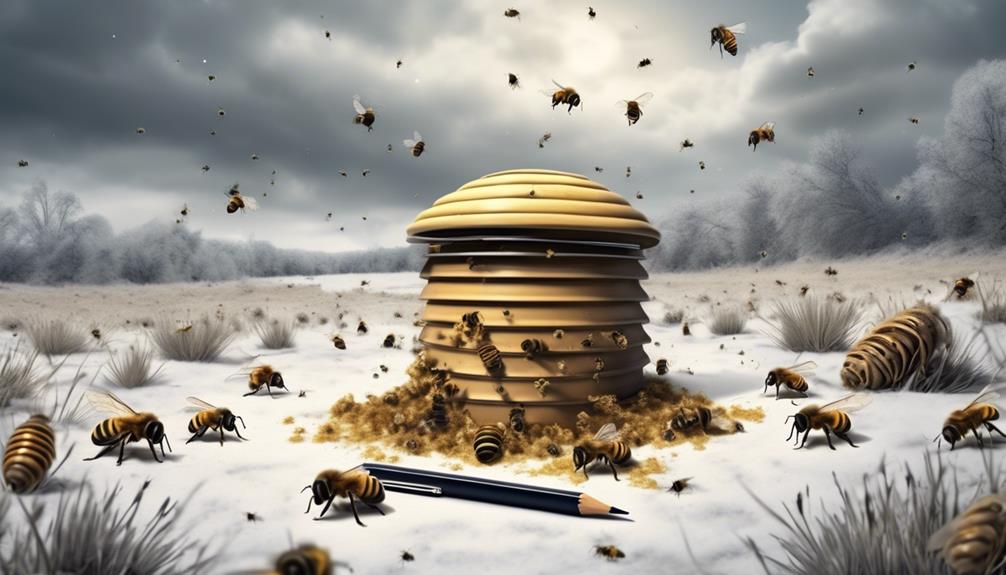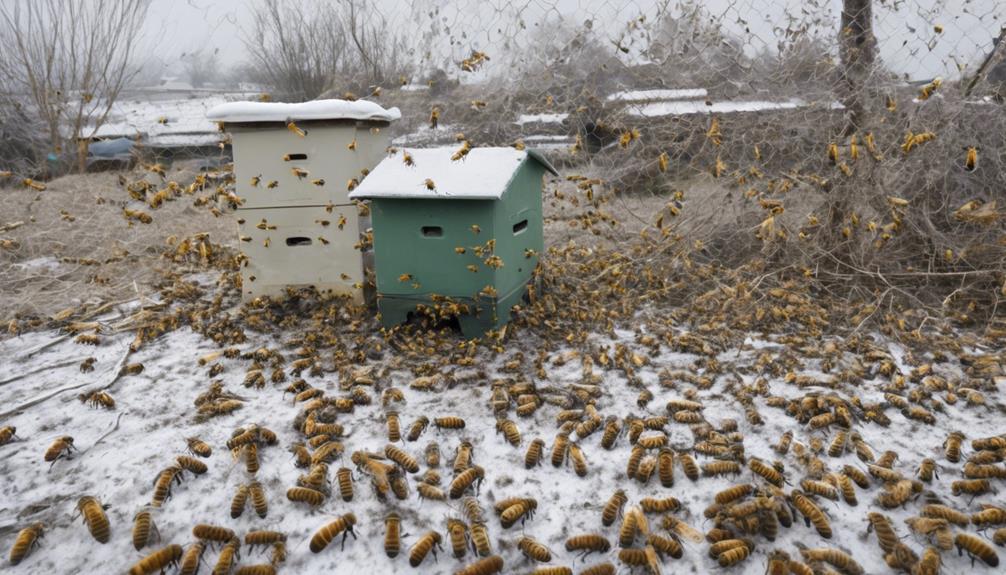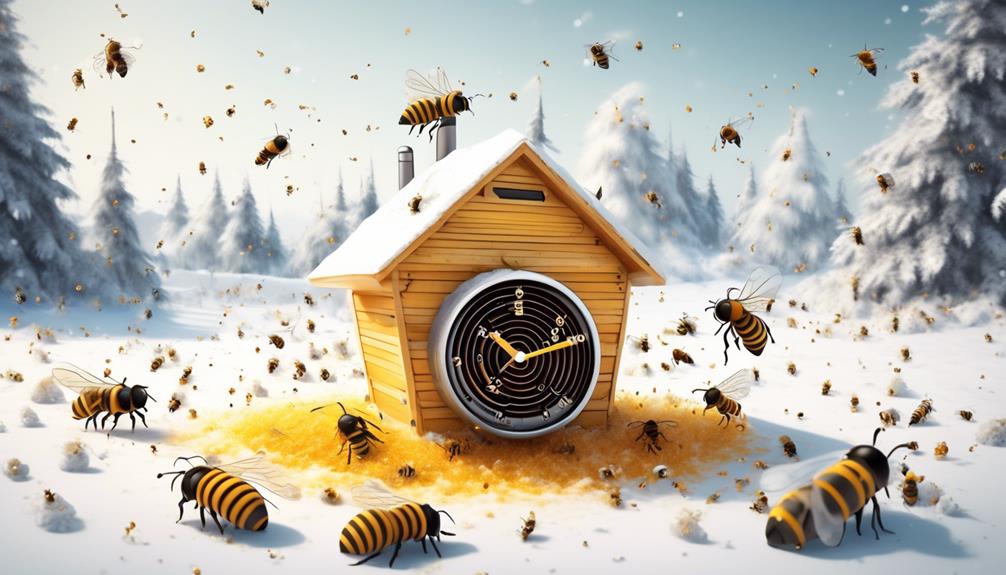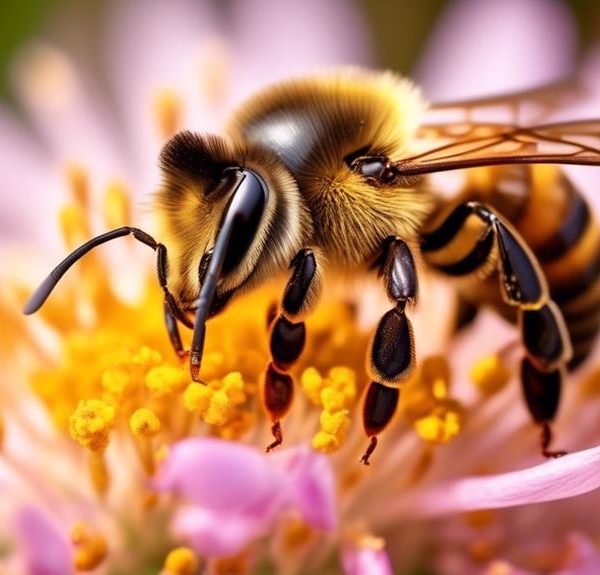Get to the bottom of your winter bee losses by understanding their behavior and investigating potential causes of their mysterious demise.

How to Figure Out Why My Bees Died Over Winter?
Imagine you're a detective, piecing together clues from a curious case. Instead of a crime scene, you're presented with a quiet hive, once buzzing with life but now eerily silent.
Winter's merciless chill has claimed your bees, and you're left wondering, 'Why?' You've heard that up to 30% of hives can be lost over winter, but why was yours part of that statistic? You feel a pang of responsibility; after all, these were your bees.
So, where to begin? The answer lies in not only understanding the typical behavior of bees during the winter months but also the various factors that could have contributed to their untimely demise.
As we venture deeper, you'll uncover that it's often not just one thing that leads to a hive's downfall but rather a deadly cocktail of circumstances.
Let's start our investigation, shall we?
Key Takeaways
- Insufficient honey stores and lack of heat generation can lead to bee deaths over winter.
- Common diseases like Nosema, Varroa mites, Chronic Bee Paralysis Virus, American Foulbrood, and pesticide poisoning can weaken and kill bee colonies.
- Pesticides have a detrimental impact on bees, affecting their nervous systems, foraging abilities, communication, and winter survival rates.
- Climate and weather conditions, such as sudden temperature fluctuations, freezing, excessive moisture, high humidity, and severe weather, can also contribute to bee deaths over winter.
Understanding Bee's Winter Behavior

To truly grasp the intricacies of bee deaths during winter, you must first understand the unique behavior bees exhibit during this icy season. Unlike other insects, bees don't hibernate. Instead, they form a winter cluster in their hive. The worker bees surround the queen and shiver, creating heat to keep the hive warm. They're essentially their own little furnace, but they can't keep it up forever. They need food, specifically honey, to generate this heat.
If there's not enough honey, they starve, often leading to high mortality rates. You've got to consider whether the beehive had a sufficient honey store for the winter. If not, the bees were likely unable to generate the necessary heat.
Additionally, bees need to leave the hive to defecate. They wait for the warm days to do this, but if there are prolonged periods of extreme cold, they'll hold it in. This can lead to dysentery and, eventually, death. So, if your bees died during winter, it's essential to analyze these factors. Understanding bees' winter behavior opens the door to figuring out why they didn't make it through the season.
Common Diseases Affecting Bees

While analyzing winter behaviors can provide one set of answers, you also need to consider the common diseases that often plague bees, as these illnesses can also contribute significantly to their winter mortality.
One of the most common diseases affecting bees is Nosema, a fungal disease that can cause severe dysentery, leading to a weak colony that can't survive winter's harsh conditions.
You should also be wary of the Varroa mite, a parasite that not only drains the bees' vital resources but also transmits viruses.
Chronic Bee Paralysis Virus (CBPV) is another disease to look out for. It can cause a disruption in the bees' ability to fly and crawl, resulting in them being expelled from the hive and eventually dying of cold.
American Foulbrood (AFB) is a bacterial disease that can wipe out an entire colony if not detected and treated early. It's known for its foul smell and ropy, sunken capped brood.
Lastly, don't overlook the possibility of Pesticide poisoning. While not a disease, exposure to certain pesticides can severely weaken a hive, leaving it vulnerable to diseases and the harsh winter conditions.
Impact of Pesticides on Bees

Navigating the complex world of pesticides, you'll soon discover their profound impact on bees, often leading to weakened hives and increased susceptibility to diseases and harsh winter conditions. Pesticides, particularly neonicotinoids and pyrethroids, are known to disrupt bees' nervous systems, affecting their ability to forage, communicate, and reproduce effectively.
You may be wondering how these pesticides end up affecting bees. They're often present in the nectar and pollen of treated plants, which bees bring back to the hive. Over time, this can lead to the buildup of toxic residues within the hive. Even at non-lethal levels, these pesticides can seriously impair a colony's health and vitality.
Moreover, pesticides can exacerbate the effects of other stressors. For instance, they can increase bees' vulnerability to Varroa mites and Nosema, common bee pathogens. The weakened state of pesticide-exposed bees can also lead to poor winter survival rates.
It's critical to understand the role of pesticides in bee health to protect your hives. You've to reduce exposure to these chemicals wherever possible and boost your bees' resilience through proper management and nutrition.
Role of Climate and Weather

Aside from pesticides, you should also consider the crucial role that climate and weather play in bee survival, particularly during the harsh winter months. Sudden temperature fluctuations can be fatal to your hive. Bees, like many other insects, are cold-blooded creatures, and their activity levels are greatly affected by temperature changes. An unusually warm winter day can cause bees to venture out of the hive, only for them to freeze when the temperature drops again.
Moreover, excessive moisture is another weather-related factor detrimental to your bees' health. Wet winters can lead to mold growth in the hive, compromising the bees' living conditions and food supplies. High humidity levels can also cause condensation inside the hive, leading to a cold, damp environment, which isn't conducive to bee survival.
Lastly, severe weather conditions like blizzards and freezing rain can physically damage the hive, leaving the bees exposed to the elements. If your locale is prone to such conditions, it's essential to take preventative measures such as hive insulation or windbreak installation.
Preventive Measures for Bee Survival

To safeguard your bees against the brutalities of winter, adopting certain preventive measures can significantly enhance their chances of survival.
Firstly, ensure you've got strong, healthy colonies entering winter. Diseases and parasites can weaken your hive, so it's essential to treat any health issues before the cold sets in.
Secondly, adequate food supplies are crucial for winter survival. Bees consume more honey during winter to generate heat, therefore, check and supplement their food reserves as necessary. Ideally, a hive should have about 60 pounds of honey for winter.
Thirdly, proper hive insulation can make a difference. Bees generate heat, but they need help keeping it in. An insulated hive wrap can help retain heat, but be sure there's enough ventilation to prevent condensation.
Lastly, consider the hive's location. A place that gets morning sun but is shielded from harsh winds can greatly benefit your bees.
Frequently Asked Questions
What Are Some Signs That My Bees May Be Dying During Winter?
You'll want to look for telltale signs of distress in your hive during winter months. If you notice a lack of activity, or see bees clustering at the hive's entrance, it could mean trouble. Check for dead bees near the entrance or inside the hive.
Also, inspect for signs of disease or pests. A sudden decrease in honey production could also be a warning sign. It's crucial to monitor these signs to keep your hive healthy.
Can the Type of Honey Produced by My Bees Indicate Their Health?
Yes, the type of honey your bees produce can indicate their health. If you notice a change in the color, taste, or consistency of the honey, it could be a sign of disease or malnutrition.
For instance, dark, bitter honey might mean your bees are sick. Be sure to monitor your hive's honey production and consult with a beekeeper if you're concerned about your bees' well-being.
How Do I Determine the Cause of Death After Discovering a Dead Bee Colony?
To determine what killed your bee colony, you'll need to perform a thorough inspection. Look for signs of disease, such as discolored, deformed, or mite-infested bees.
Examine the hive's food stores and structure. Was there enough food? Was the hive properly insulated from the cold?
You'll also want to consider environmental factors. Pesticide exposure or extreme weather could've played a role.
It's a process of elimination to identify the cause.
Can Other Insects or Pests Contribute to a Bee Colony's Winter Death?
Yes, other pests can contribute to a bee colony's winter death.
Mites, such as Varroa destructors, can weaken your bees, making them more susceptible to disease and the cold.
Wax moths and hive beetles can also damage the colony.
Therefore, it's crucial to monitor for these pests regularly and take action if you spot them.
They're not the only possible cause of winter losses, but they're certainly a significant factor to consider.
Is There a Specific Time During Winter When Bees Are Most Vulnerable to Death?
Yes, there is.
Bees are most vulnerable in late winter, particularly in February and March. It's during this period they're relying heavily on their stored food. If they've depleted these reserves, they'll starve.
Also, the colony's population will be at its lowest, making it harder to maintain the hive's temperature.
Conclusion
You've learned about bee behavior in winter and the common diseases, pesticide effects, and weather impact that can affect them. Understanding these factors can help you decipher why your bees didn't survive the cold season. Implementing preventive measures can significantly enhance their survival.
Keep observing, learning, and adapting your beekeeping strategies for a healthier hive next winter. It's a complex task, but with patience and diligence, you can ensure your bees thrive year-round.



